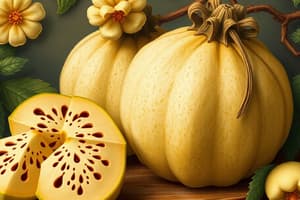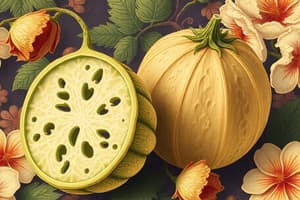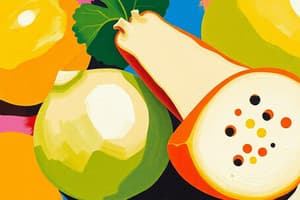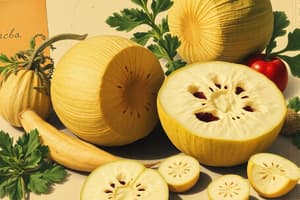Podcast
Questions and Answers
What type of plant is jicama classified as?
What type of plant is jicama classified as?
- Woody plant
- Shrub
- Herbaceous vine (correct)
- Annual plant
Which characteristic defines jicama as a perennial plant?
Which characteristic defines jicama as a perennial plant?
- It can grow for more than four years
- It reproduces only once a year
- It lives longer than two years (correct)
- It does not need sunlight to grow
What is the first step in the processing of jicama after harvesting?
What is the first step in the processing of jicama after harvesting?
- Drying the root
- Cooking the tuber
- Peeling the skin (correct)
- Slicing into cubes
Where was jicama first domesticated?
Where was jicama first domesticated?
Which method is used to cut jicama after it has been peeled?
Which method is used to cut jicama after it has been peeled?
What is the primary economic purpose for which Jatropha curcas is grown?
What is the primary economic purpose for which Jatropha curcas is grown?
Which step in the oil extraction process of Jatropha curcas involves removing the moisture from harvested seeds?
Which step in the oil extraction process of Jatropha curcas involves removing the moisture from harvested seeds?
What is the final step in processing Jatropha oil before it can be used for various applications?
What is the final step in processing Jatropha oil before it can be used for various applications?
Which part of the Jatropha curcas plant is primarily used for oil extraction?
Which part of the Jatropha curcas plant is primarily used for oil extraction?
What type of plant is Jatropha curcas classified as?
What type of plant is Jatropha curcas classified as?
Which of the following statements accurately describes a root crop?
Which of the following statements accurately describes a root crop?
Which of the following is classified as a bulb?
Which of the following is classified as a bulb?
What is the primary function of taproots in root crops?
What is the primary function of taproots in root crops?
Which of the following is NOT considered a green vegetable crop?
Which of the following is NOT considered a green vegetable crop?
Which family do the major food bulbs like onions and garlic belong to?
Which family do the major food bulbs like onions and garlic belong to?
What caused the severe famine in Ireland in the mid-1800s?
What caused the severe famine in Ireland in the mid-1800s?
Which of the following statements about potatoes is correct?
Which of the following statements about potatoes is correct?
Which yam species is known for producing tubers that can weigh up to 20 kg?
Which yam species is known for producing tubers that can weigh up to 20 kg?
What is the primary method of propagating yams?
What is the primary method of propagating yams?
What must be done to taro before it is safely consumed?
What must be done to taro before it is safely consumed?
What chemical substances mainly contribute to the flavor and aroma of spices?
What chemical substances mainly contribute to the flavor and aroma of spices?
Why were spices initially used in food preservation?
Why were spices initially used in food preservation?
Which of the following regions was a significant source for exotic spices during the Spice Trade?
Which of the following regions was a significant source for exotic spices during the Spice Trade?
What impact did Marco Polo's expeditions have on Europe?
What impact did Marco Polo's expeditions have on Europe?
What made the overland caravan trade routes unreliable and expensive for spice supply to Europe?
What made the overland caravan trade routes unreliable and expensive for spice supply to Europe?
Which sea route did Vasco de Gama discover in 1499?
Which sea route did Vasco de Gama discover in 1499?
What was a significant economic impact of the plantations established by the Dutch and British by the mid-1800s?
What was a significant economic impact of the plantations established by the Dutch and British by the mid-1800s?
Which member of the Mint Family is known for its sharp, pungent flavor and is widely used in cooking?
Which member of the Mint Family is known for its sharp, pungent flavor and is widely used in cooking?
What is a key characteristic of the essential oils found in the Mint Family plants?
What is a key characteristic of the essential oils found in the Mint Family plants?
What does the energy balance measure in bioethanol production?
What does the energy balance measure in bioethanol production?
What innovation is necessary for efficient bioethanol production from non-tropical species like switchgrass?
What innovation is necessary for efficient bioethanol production from non-tropical species like switchgrass?
Which country has achieved the highest energy balance for bioethanol production?
Which country has achieved the highest energy balance for bioethanol production?
What historical factor significantly contributed to the establishment of large sugar plantations in the Caribbean?
What historical factor significantly contributed to the establishment of large sugar plantations in the Caribbean?
What aspect of sugar cane makes it beneficial for bioethanol production compared to other plants?
What aspect of sugar cane makes it beneficial for bioethanol production compared to other plants?
What distinguishes starch from cellulose in terms of glucose unit linkage?
What distinguishes starch from cellulose in terms of glucose unit linkage?
Which statement accurately describes the digestibility of starch and cellulose?
Which statement accurately describes the digestibility of starch and cellulose?
What is the main source of bioethanol production?
What is the main source of bioethanol production?
Which characteristic makes bioethanol a sustainable energy source?
Which characteristic makes bioethanol a sustainable energy source?
Which component of plant cells is primarily made up of cellulose?
Which component of plant cells is primarily made up of cellulose?
What distinguishes saturated fats from unsaturated fats?
What distinguishes saturated fats from unsaturated fats?
Which of the following describes trans double bonds?
Which of the following describes trans double bonds?
What is a consequence of hydrogenation in oils?
What is a consequence of hydrogenation in oils?
Which characteristic is associated with highly unsaturated plant oils?
Which characteristic is associated with highly unsaturated plant oils?
What is a potential health impact of consuming trans fatty acids?
What is a potential health impact of consuming trans fatty acids?
What is the primary process used to produce biodiesel from plant oils?
What is the primary process used to produce biodiesel from plant oils?
Which plant oil has the highest production efficiency for biodiesel according to the provided data?
Which plant oil has the highest production efficiency for biodiesel according to the provided data?
What significant environmental advantage does biodiesel have over petroleum-based diesel?
What significant environmental advantage does biodiesel have over petroleum-based diesel?
Which characteristic of canola oil makes it suitable for cooking and food products?
Which characteristic of canola oil makes it suitable for cooking and food products?
What is the primary reason that biodiesel produced from canola oils may face operational challenges in cold weather?
What is the primary reason that biodiesel produced from canola oils may face operational challenges in cold weather?
Which statement accurately describes the extraction of sunflower oil?
Which statement accurately describes the extraction of sunflower oil?
What is the primary benefit of flaxseed oil derived from edible flax seeds?
What is the primary benefit of flaxseed oil derived from edible flax seeds?
Which characteristic of the olive tree contributes to its cultivation regions?
Which characteristic of the olive tree contributes to its cultivation regions?
What processing method is necessary for unripe olives to become edible?
What processing method is necessary for unripe olives to become edible?
Which component accounts for about 40% of the olive fruit and contributes to its nutritional value?
Which component accounts for about 40% of the olive fruit and contributes to its nutritional value?
What role does latex play in plants?
What role does latex play in plants?
What is the primary mechanism by which vulcanization enhances rubber?
What is the primary mechanism by which vulcanization enhances rubber?
Which of the following statements about the Para rubber tree is true?
Which of the following statements about the Para rubber tree is true?
What type of substance is crude rubber classified as?
What type of substance is crude rubber classified as?
Which compound is primarily responsible for the structure of polyterpenes in latex?
Which compound is primarily responsible for the structure of polyterpenes in latex?
What is the primary function of natural rubber in the manufacturing of modern radial tires?
What is the primary function of natural rubber in the manufacturing of modern radial tires?
Which of the following statements about synthetic rubber is accurate?
Which of the following statements about synthetic rubber is accurate?
What significant impact did the rubber boom from 1879 to 1912 have on Manaus, Brazil?
What significant impact did the rubber boom from 1879 to 1912 have on Manaus, Brazil?
How did indigenous peoples in Brazil use rubber to create clothing?
How did indigenous peoples in Brazil use rubber to create clothing?
What was a major disadvantage of crude rubber used historically during the 1700s and 1800s?
What was a major disadvantage of crude rubber used historically during the 1700s and 1800s?
What is the primary purpose of ginning in the processing of cotton?
What is the primary purpose of ginning in the processing of cotton?
Which method involves decomposing freshly harvested plant material in stagnant water to obtain plant fibers?
Which method involves decomposing freshly harvested plant material in stagnant water to obtain plant fibers?
What characteristic of plant fibers influences their use in various applications?
What characteristic of plant fibers influences their use in various applications?
What type of fibers are primarily extracted using the decortication method?
What type of fibers are primarily extracted using the decortication method?
What is the primary reason that monocultures are more efficiently harvested?
What is the primary reason that monocultures are more efficiently harvested?
What is the primary composition of fresh cotton fibres?
What is the primary composition of fresh cotton fibres?
What process is mainly used to clean cotton fibres after harvesting?
What process is mainly used to clean cotton fibres after harvesting?
What is the purpose of the mercerization process in cotton manufacturing?
What is the purpose of the mercerization process in cotton manufacturing?
Which of the following best describes the characteristics of kapok fibres?
Which of the following best describes the characteristics of kapok fibres?
What is the primary commercial use of robusta coffee?
What is the primary commercial use of robusta coffee?
Where were the first coffee houses established in the early 1700s?
Where were the first coffee houses established in the early 1700s?
What environmental condition is essential for growing coffee plants?
What environmental condition is essential for growing coffee plants?
Which of the following coffee species is known for its superior flavor?
Which of the following coffee species is known for its superior flavor?
What is the primary difference in processing between black tea and green tea?
What is the primary difference in processing between black tea and green tea?
Which countries are identified as the largest producers of tea?
Which countries are identified as the largest producers of tea?
Which step is NOT part of the black tea production process?
Which step is NOT part of the black tea production process?
What climate conditions are optimal for growing tea?
What climate conditions are optimal for growing tea?
When was coffee first introduced to the Caribbean?
When was coffee first introduced to the Caribbean?
Flashcards
Jicama plant family
Jicama plant family
The plant family is not specified in this document.
Jicama plant type
Jicama plant type
Herbaceous vine, herb, perennial.
Jicama native distribution
Jicama native distribution
The native region of the jicama is not specified in the article.
Jicama domestication location
Jicama domestication location
Signup and view all the flashcards
How jicama is harvested/processed
How jicama is harvested/processed
Signup and view all the flashcards
Jatropha plant family
Jatropha plant family
Signup and view all the flashcards
Jatropha plant type
Jatropha plant type
Signup and view all the flashcards
Jatropha native distribution
Jatropha native distribution
Signup and view all the flashcards
Jatropha economic use
Jatropha economic use
Signup and view all the flashcards
Jatropha oil extraction process
Jatropha oil extraction process
Signup and view all the flashcards
What are 'root crops'?
What are 'root crops'?
Signup and view all the flashcards
What are 'true roots'?
What are 'true roots'?
Signup and view all the flashcards
What are 'taproots'?
What are 'taproots'?
Signup and view all the flashcards
Bulb
Bulb
Signup and view all the flashcards
What are 'green' vegetables?
What are 'green' vegetables?
Signup and view all the flashcards
Potato origin
Potato origin
Signup and view all the flashcards
Potato introduction to Europe
Potato introduction to Europe
Signup and view all the flashcards
Potato blight
Potato blight
Signup and view all the flashcards
Yam types
Yam types
Signup and view all the flashcards
Taro: corm
Taro: corm
Signup and view all the flashcards
Spice trade route change
Spice trade route change
Signup and view all the flashcards
European spice monopolies
European spice monopolies
Signup and view all the flashcards
Mint family spices
Mint family spices
Signup and view all the flashcards
Rosemary's culinary use
Rosemary's culinary use
Signup and view all the flashcards
Thyme's versatility
Thyme's versatility
Signup and view all the flashcards
What are spices?
What are spices?
Signup and view all the flashcards
How do spices create their aroma?
How do spices create their aroma?
Signup and view all the flashcards
Why were spices used in ancient times?
Why were spices used in ancient times?
Signup and view all the flashcards
What is the trans-Asian Spice Trade?
What is the trans-Asian Spice Trade?
Signup and view all the flashcards
What role did the Crusades play in the spice trade?
What role did the Crusades play in the spice trade?
Signup and view all the flashcards
Monosaccharide
Monosaccharide
Signup and view all the flashcards
Disaccharide
Disaccharide
Signup and view all the flashcards
Starch
Starch
Signup and view all the flashcards
Cellulose
Cellulose
Signup and view all the flashcards
Bioethanol
Bioethanol
Signup and view all the flashcards
Energy Balance in Bioethanol
Energy Balance in Bioethanol
Signup and view all the flashcards
Bioethanol Production Efficiency
Bioethanol Production Efficiency
Signup and view all the flashcards
Sugarcane for Bioethanol
Sugarcane for Bioethanol
Signup and view all the flashcards
Cellulose and Bioethanol
Cellulose and Bioethanol
Signup and view all the flashcards
Energy Balance of Corn Starch Bioethanol
Energy Balance of Corn Starch Bioethanol
Signup and view all the flashcards
Plant Oils
Plant Oils
Signup and view all the flashcards
Saturated Fat
Saturated Fat
Signup and view all the flashcards
Unsaturated Fat
Unsaturated Fat
Signup and view all the flashcards
Hydrogenation
Hydrogenation
Signup and view all the flashcards
Trans Fats
Trans Fats
Signup and view all the flashcards
What makes canola oil unique?
What makes canola oil unique?
Signup and view all the flashcards
What's special about biodiesel?
What's special about biodiesel?
Signup and view all the flashcards
What is transesterification?
What is transesterification?
Signup and view all the flashcards
How does energy balance relate to biodiesel?
How does energy balance relate to biodiesel?
Signup and view all the flashcards
What impacts biodiesel production?
What impacts biodiesel production?
Signup and view all the flashcards
Sunflower Oil Uses
Sunflower Oil Uses
Signup and view all the flashcards
Flaxseed Oil: Edible vs. Industrial
Flaxseed Oil: Edible vs. Industrial
Signup and view all the flashcards
Olive Oil Extraction
Olive Oil Extraction
Signup and view all the flashcards
Olive Oil Composition
Olive Oil Composition
Signup and view all the flashcards
Olive Harvest Uses
Olive Harvest Uses
Signup and view all the flashcards
What is latex?
What is latex?
Signup and view all the flashcards
How does latex protect plants?
How does latex protect plants?
Signup and view all the flashcards
What is vulcanization?
What is vulcanization?
Signup and view all the flashcards
Why is carbon black added to rubber?
Why is carbon black added to rubber?
Signup and view all the flashcards
What are the properties of cured natural rubber?
What are the properties of cured natural rubber?
Signup and view all the flashcards
What is natural rubber?
What is natural rubber?
Signup and view all the flashcards
How is natural rubber different from synthetic rubber?
How is natural rubber different from synthetic rubber?
Signup and view all the flashcards
Why was the Amazon rubber boom important?
Why was the Amazon rubber boom important?
Signup and view all the flashcards
What were some traditional uses of rubber?
What were some traditional uses of rubber?
Signup and view all the flashcards
What are the key properties of natural rubber?
What are the key properties of natural rubber?
Signup and view all the flashcards
Ginning
Ginning
Signup and view all the flashcards
Retting
Retting
Signup and view all the flashcards
Decortication
Decortication
Signup and view all the flashcards
Gossypium hirsutum
Gossypium hirsutum
Signup and view all the flashcards
Vulcanization
Vulcanization
Signup and view all the flashcards
Why are monocultures efficient?
Why are monocultures efficient?
Signup and view all the flashcards
What are cotton fibers?
What are cotton fibers?
Signup and view all the flashcards
How is cotton prepared for yarn?
How is cotton prepared for yarn?
Signup and view all the flashcards
What is kapok?
What is kapok?
Signup and view all the flashcards
What are the key differences between cotton fiber and kapok?
What are the key differences between cotton fiber and kapok?
Signup and view all the flashcards
Lloyd's of London's Origin
Lloyd's of London's Origin
Signup and view all the flashcards
Coffee's Global Journey
Coffee's Global Journey
Signup and view all the flashcards
What makes tea special?
What makes tea special?
Signup and view all the flashcards
Black Tea vs. Green Tea: Processing
Black Tea vs. Green Tea: Processing
Signup and view all the flashcards
Tea's Global Journey
Tea's Global Journey
Signup and view all the flashcards
What are the two main coffee species?
What are the two main coffee species?
Signup and view all the flashcards
What are the key steps in coffee processing?
What are the key steps in coffee processing?
Signup and view all the flashcards
Where did coffee drinking originate?
Where did coffee drinking originate?
Signup and view all the flashcards
What is the difference in quality between Arabica and Robusta coffee?
What is the difference in quality between Arabica and Robusta coffee?
Signup and view all the flashcards
How did coffee spread to Europe?
How did coffee spread to Europe?
Signup and view all the flashcards
Study Notes
Jicama (Pachyrhizus erosus)
- Family: Pea family (Fabaceae)
- Type of plant: Herbaceous vine
- Lifespan: Perennial (lives longer than 2 years)
- Native distribution: Mexico and Central America
History as a Food Plant
- Domestication: First domesticated in Mexico, archaeological sites date to 3000 BC, also found in Peru.
- Widely grown: Central America and Southeast Asia
- Introduction to Asia: Introduced by the Spanish in the 17th century.
- Popularity: Popular in the Philippines, China, and other parts of the region.
Utilization
- Part used: Tuberous root
- Processing:
- Harvesting: Taproot system, harvested from the ground.
- Peeling: Thin, brown skin is peeled off.
- Cutting: Cut into sticks, cubes, or slices.
- Consumption: Raw in salads, salsas, crunchy snacks (with lime juice and chili powder); cooked in stir-fries, soups, and stews (retains crisp texture).
Studying That Suits You
Use AI to generate personalized quizzes and flashcards to suit your learning preferences.




